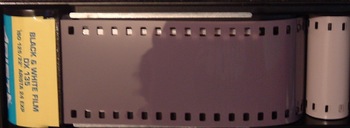Photographic film

Photographic film is a sheet of plastic for recording visual scenes. The plastic has been specially treated to be sensitive to light. The image is recorded on the plastic when the plastic is exposed to light. Film is kept in small canisters (boxes) which protect it from the light. A normal photographic film may hold up to 40 pictures.
Once all pictures have been recorded, the film has to undergo a special chemical treatment. This is called developing a film or film processing. That treatment makes the pictures visible (you can see them), and the exposed film is no longer sensitive to light.[1]
Different kinds of films exist. Some require more light to be exposed than others. Some are black and white only; they record no colors. There are also special films which can record infrared light. Photographic film was invented in the 1880s and replaced the earlier dry plate system.
Films also come in different sizes. 35 millimeter film, the most used size, comes in metal cans or canisters, but there are other camera films that come in paper wrappings or in single sheets.
Uses[change | change source]
Film can only be used once. After that, it cannot be used again (if it is accidentally used again, this results in an artifact called a multiple exposure). When not in use, film needs to be covered from light, otherwise it will record any lights that shine on it. This will make it useless to record a picture. Film comes in a can called a canister to cover it from light rays.
Film needs the right amount of light to make a picture. If the picture is too bright or too dark, it will not record correctly. The longer that the film keeps recording, the more light it will get. If what is being photographed is bright, it will be recorded faster. If it is darker, the film will need more time to record.
Films that need less time to record the picture are known as "faster" films. Different speeds of films are marked with an ISO number. The higher the number, the faster the films. Films can only make a picture from focused lights. If there is no lens to focus light, the film will only turn white from receiving just the light. If a film with an ISO level of 200 instead of 100 is used, it will only need half as much time to record a picture of the same scene.
Examples of ISO numbers are ISO 50, ISO 100, IS0 200, ISO 400, ISO 800, and ISO 1600. The ISO number is sometimes called the ''ASA number'' or the ''film speed''. When the ISO number is low, for example ISO 50, the film takes a long time to record the picture. This is called a slow film. This means the shutter has to stay open for a long time. When the ISO number is high, for example ISO 800, the picture is made in a very short time. This is a fast film. This means the shutter has to open and close quickly.
Before photographic film was invented, photography used glass dry plates. In the 21st century, digital cameras have replaced film cameras for most uses.[2] Film is still made, and many professional photographers and cinematographers prefer film.
References[change | change source]
- ↑ Anchell, Steve 2008. The Darkroom Cookbook p.103-105. Elsevier, Oxford. ISBN 978-0-240-81055-3
- ↑ Rogers, David 2007. The Chemistry of Photography: from classical to digital technologies. Cambridge, UK: The Royal Society of Chemistry. ISBN 978-0-85404-273-9
